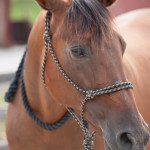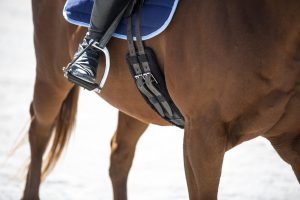Yesterday I posted an article to a horse forum that I follow presenting the idea of using more positive reinforcement in training horses. Although I was not surprised by the variety of opinions expressed in response to my post, I did get the impression that perhaps the true meaning of positive reinforcement, and the intent of my post were not completely understood.
So I decided to take the feedback that I received on the forum and rewrite this article so that hopefully my true intent for the writing will be more clear.
Let me begin by saying that I believe the term “positive reinforcement” is often connected to feeding your horse lots of treats and petting him a lot, which to many horse owners sounds like a bunch of ineffective fluff. Likewise, “negative reinforcement” sounds bad, so it is assumed to mean something abusive.
Let me start by defining the four componets of operative conditioning, a method of learning described by behaviorist B.F. Skinner. I have copied these definitions directly from where I found them (https://www.verywell.com/operant-conditioning-a2-2794863).
Reinforcement is any event that strengthens or increases the behavior it follows. There are two kinds of reinforcers:
Positive reinforcers are favorable events or outcomes that are presented after the behavior. In situations that reflect positive reinforcement, a response or behavior is strengthened by the addition of something, such as praise or a direct reward.
Negative reinforcers involve the removal of an unfavorable events or outcomes after the display of a behavior. In these situations, a response is strengthened by the removal of something considered unpleasant.
In both of these cases of reinforcement, the behavior increases.
Punishment, on the other hand, is the presentation of an adverse event or outcome that causes a decrease in the behavior it follows. There are two kinds of punishment:
Positive punishment, sometimes referred to as punishment by application, involves the presentation of an unfavorable event or outcome in order to weaken the response it follows.
Negative punishment, also known as punishment by removal, occurs when a favorable event or outcome is removed after a behavior occurs.
In both of these cases of punishment, the behavior decreases.
As you can see through these definitions, you must not think of “positive” and “negative” in a literal sense, more in a mathematical sense to understand these definitions.
What I want to do is give you a few examples of the above reinforcers and punishments as related to horse training.
Positive Reinforcement: It doesn’t necessarily mean treats. Positive reinforcement can be rest, praise, or food. You can use safety and comfort as positive reinforcement, which can be very effective with horses. Example: You are just starting to teach your horse to jump, after a few tries he has a nice effort, so you praise him and end the ride for the day.
Negative Reinforcement: Pressure and release, you squeeze your horse’s sides and when he walks forward you release the pressure
Positive Punishment: Your horse bites you and you smack him (an unfavorable event for the horse)
Negative Punishment: You were scratching a young horse and he reaches around to groom you back, but is too rough so you stop scratching and walk away.
As you can see from the examples, every one of these four parts of “training” has its place in our interaction with horses. I do make the argument that a lot of common riding and training is done mostly through pressure and release (which is negative reinforcement), with very little positive reinforcement. I would like to cite four resources that talk more about the potential benefits of positive reinforcement.
Positive Reinforcement Improves Horse Memory
http://www.thehorse.com/articles/25017/training-positive-reinforcement-improves-horse-memory
Positive, Negative Reinforcement in Horse Training Compared
http://www.thehorse.com/articles/32383/positive-negative-reinforcement-in-horse-training-compared
Complete Training of Horse and Rider by Alois Podhajsky
http://www.amazon.com/Complete-Training-Horse-Rider-Podhajsky/dp/0879802359
Don’t Shoot the Dog
http://www.amazon.com/Dont-Shoot-Dog-Teaching-Training/dp/1860542387
We all get stuck doing things the way we have always done them. I am certainly no exception to this! My intention for this article was simply for us all to take a step back, look at what we do with our horses and ask ourselves – What could we do differently? What might be better for our horses? There are many great resources and knowledgeable people out there, new and old, that we can learn from. Let’s just keep open minds and know that there is always more to learn!
Have a great weekend!














3 Responses
I think this is among the most significant info for me.
And i am glad reading your article. But should remark on few general things, The web site style is great, the
articles is really nice : D. Good job, cheers
my page – diatomaceous earth; http://diatomaceousearthfoodgrade.org,
Yes, I am on that “horse forum” site and witnessed the reaction to your post. I wasn’t surprised. I, for one, appreciate your “lessons” that I get by email and understand your position. So many will take one little word and make an argument against it, which is not in the best interest of learning about training and riding. Too bad for them!
Hi Maggie, Thanks for your support!